Minimalist kitchen design is more than just an aesthetic choice; it’s a lifestyle statement that emphasizes simplicity, functionality, and elegance. In this comprehensive guide, we delve into the essential elements of minimalist kitchen materials, offering insights into how to create a space that is both visually appealing and highly practical.
Key Takeaways:
- Minimalist kitchens focus on simplicity and functionality, using a limited palette of materials.
- Natural light, open space, and clean lines are crucial in minimalist design.
- Sustainable materials are increasingly popular in minimalist kitchens, reflecting a growing eco-consciousness.
- Neutral color palettes and textural contrasts enhance the minimalist appeal without overwhelming the senses.
The Philosophy Behind Minimalist Kitchens
Minimalism in kitchen design is not just about the visual appeal; it’s a reflection of a lifestyle that values efficiency and clarity. This design philosophy is rooted in the idea of less being more, where every element serves a purpose, and clutter is minimized.
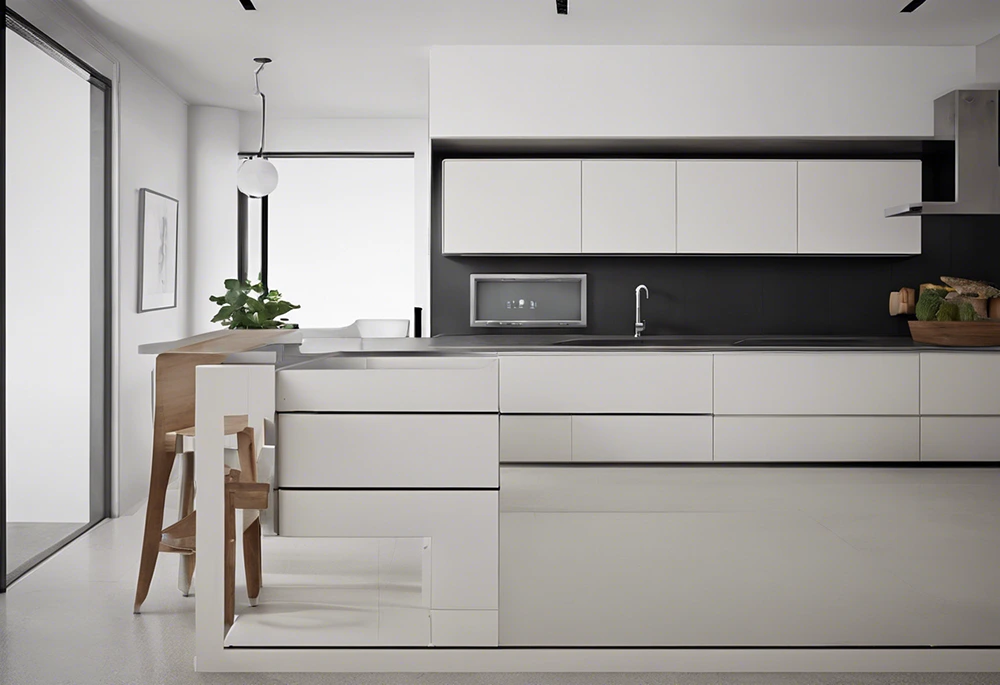
Essential Elements of Minimalist Kitchen Materials
In minimalist kitchens, the choice of materials is crucial. These materials should not only be aesthetically pleasing but also functional and durable.
Countertops
- Marble: Offers elegance and durability, but requires maintenance.
- Granite: Known for its toughness and variety of patterns.
- Quartz: A popular choice for its low maintenance and uniform look.
Cabinetry
- Wood: Brings warmth and natural beauty, available in various finishes.
- Laminate: A budget-friendly option that mimics the look of natural materials.
- Glass: Creates a sense of openness and space.
Minimalist Kitchen Countertops
The countertop is often the focal point of the kitchen, and in minimalist designs, it’s essential to choose materials that are both functional and aesthetically pleasing.
| Material | Pros | Cons |
| Marble | Timeless beauty, unique patterns | Requires regular sealing |
| Granite | Highly durable, heat resistant | Can be expensive |
| Quartz | Non-porous, uniform appearance | Less heat resistant than natural stone |
Cabinetry in Minimalist Kitchens
Cabinetry in minimalist kitchens should be sleek, with clean lines and a lack of ornate details. The materials used often reflect the overall theme of simplicity and functionality.
| Material | Characteristics | Maintenance |
| Wood | Warm, natural look | Regular cleaning, occasional refinishing |
| Laminate | Cost-effective, versatile | Easy to clean, less durable |
| Glass | Modern, opens up space | Requires frequent cleaning to avoid fingerprints |
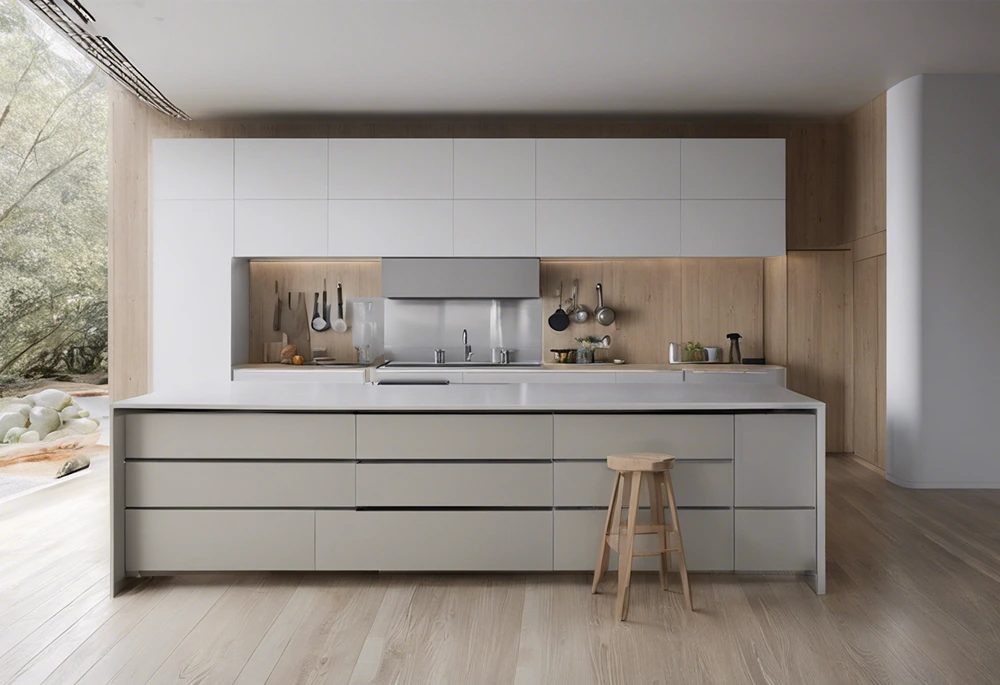
Flooring and Wall Materials in Minimalist Kitchens
The choice of flooring and wall materials can significantly impact the overall look and feel of a minimalist kitchen.
Flooring Options
- Polished Concrete: Durable and modern, but can be cold.
- Hardwood: Adds warmth, requires maintenance.
- Porcelain Tiles: Low maintenance, available in various designs.
Wall Materials
- Paint: Choose neutral or monochromatic colors for a minimalist look.
- Tiles: Subway tiles are a popular choice for their simplicity and clean lines.
- Stone: Adds texture and natural beauty.
Lighting and Fixtures in Minimalist Kitchen Design
Lighting plays a crucial role in minimalist kitchen design. It should be functional, yet unobtrusive, often using materials that complement the overall design.
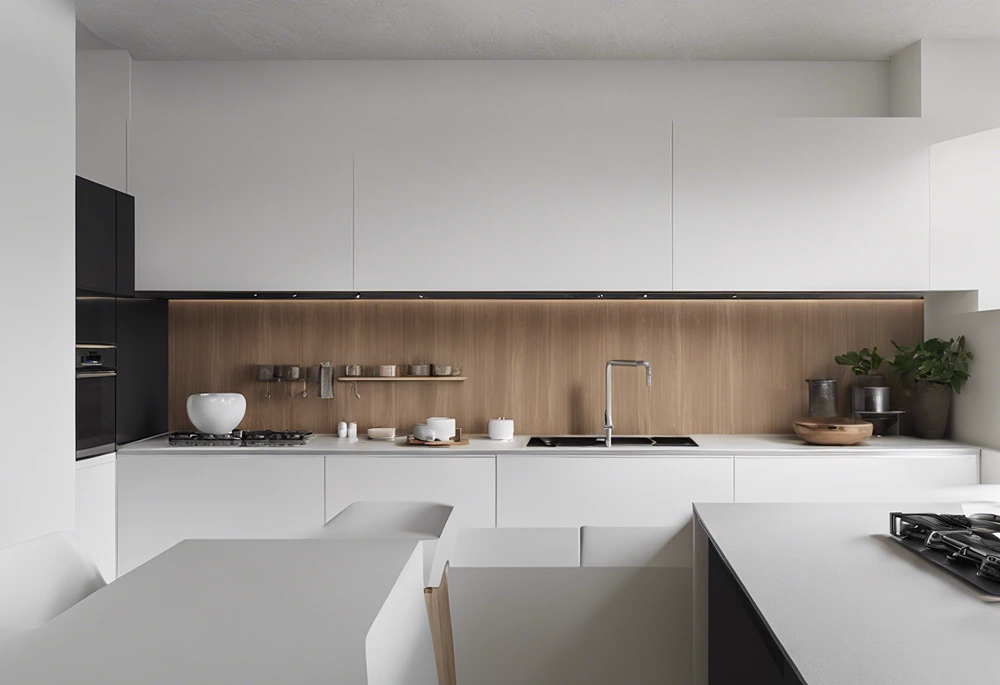
Lighting Options
- Pendant Lights: Can serve as a focal point.
- Recessed Lighting: Blends seamlessly into the ceiling.
- Under-Cabinet Lighting: Provides task lighting without clutter.
Fixture Materials
- Stainless Steel: Modern and easy to clean.
- Brushed Nickel: Subtle and less reflective.
- Matte Black: Bold and contemporary.
Color Schemes and Textures in Minimalist Kitchens
The color scheme in a minimalist kitchen is typically neutral, with an emphasis on whites, grays, and blacks. Textures play a significant role in adding depth and interest to the space.
Color Palette
- White: Creates a sense of space and cleanliness.
- Gray: Offers a soft, neutral backdrop.
- Black: Adds drama and depth.
Textural Contrast
- Wood: Adds warmth and natural texture.
- Metal: Provides a sleek, industrial feel.
- Stone: Brings an organic, earthy element.
Sustainable and Eco-Friendly Materials
Sustainability is becoming increasingly important in kitchen design. Eco-friendly materials are not only good for the environment but also add a sense of responsibility and care to the design.
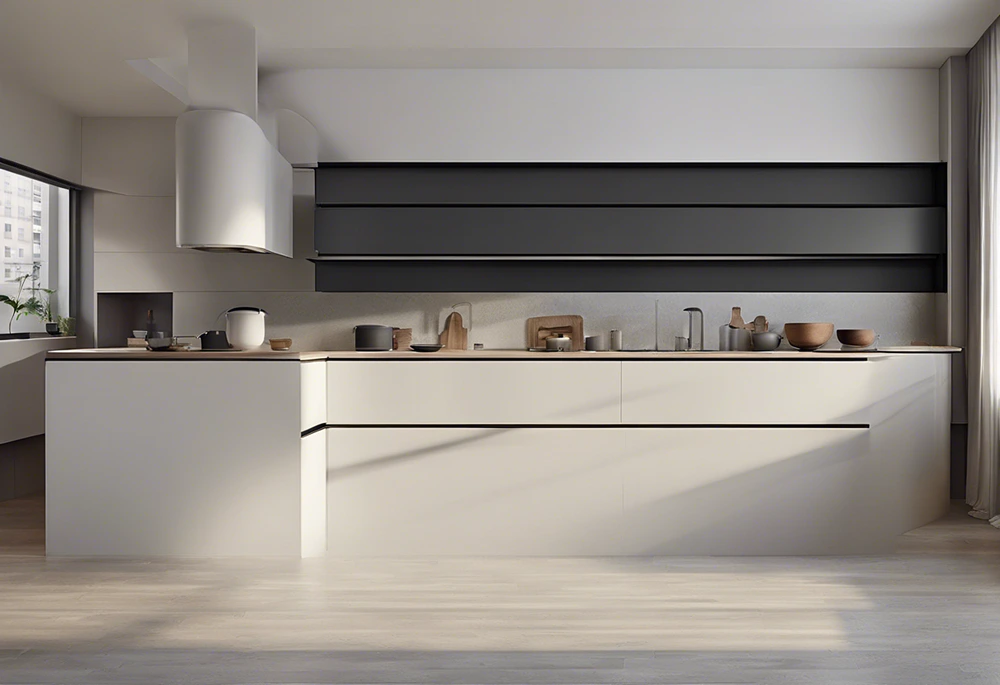
Eco-Friendly Material Options
- Bamboo: Fast-growing and sustainable.
- Recycled Glass: Unique and colorful.
- Reclaimed Wood: Reduces environmental impact.
Benefits of Sustainable Materials
- Reduced Environmental Impact: Less resource-intensive.
- Healthier Living Space: Often free from harmful chemicals.
- Long-Term Cost Savings: Durable and long-lasting.
Efficient Storage Solutions in Minimalist Kitchens
Efficient storage is key in a minimalist kitchen, where the goal is to have a place for everything and everything in its place.
Innovative Storage Ideas
- Pull-out Cabinets: Maximizes space and accessibility.
- Overhead Cabinets: Utilizes vertical space, keeping countertops clear.
- Hidden Appliances: Integrates appliances into cabinetry for a seamless look.
Storage Material Options
- Metal Shelving: Durable and sleek, adds an industrial touch.
- Wooden Drawers: Warm and natural, complements minimalist aesthetics.
- Glass Front Cabinets: Visually opens up space, ideal for displaying cherished items.
Monochromatic Schemes and Textural Diversity
A monochromatic color scheme is a hallmark of minimalist design, often featuring shades of white, gray, and black. Textural diversity adds depth and interest to these neutral palettes.
Monochromatic Color Schemes
- All-White: Timeless and clean, but requires maintenance.
- Shades of Gray: Offers a softer, more versatile backdrop.
- Black Accents: Provides bold contrasts and visual depth.
Adding Texture
- Natural Stone: Adds elegance and a unique pattern to surfaces.
- Wood Accents: Brings warmth and a tactile element.
- Metallic Finishes: Introduces a modern, industrial vibe.
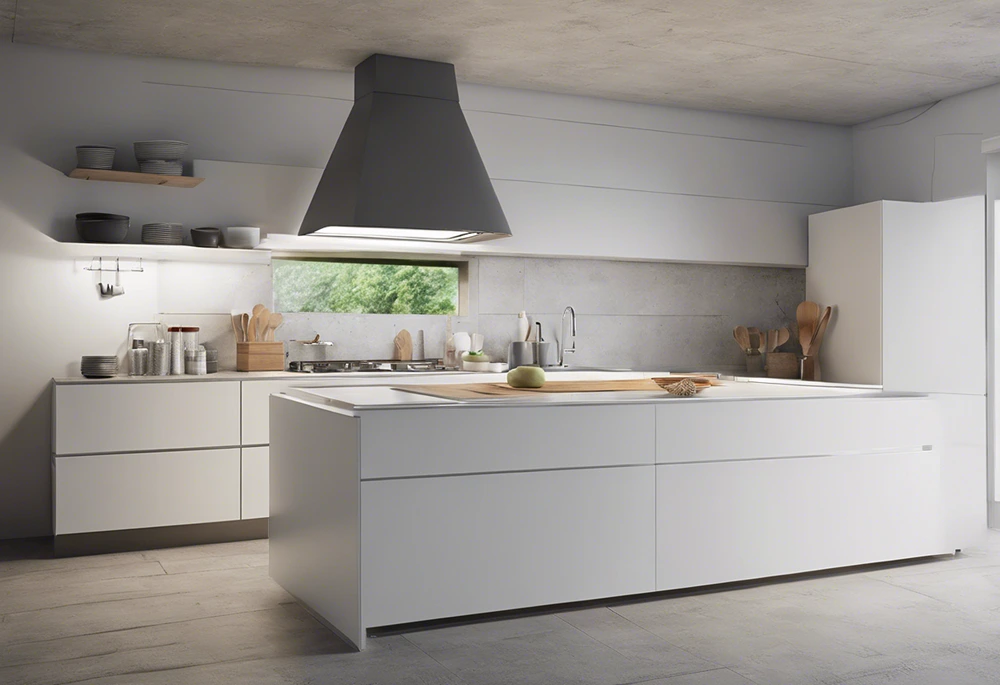
Sustainability at the Heart of Design
Incorporating sustainable materials is not only environmentally responsible but also adds a layer of authenticity and depth to minimalist kitchen design.
Eco-Friendly Materials
- Recycled Glass Countertops: Unique and sustainable.
- Bamboo Flooring: Renewable and durable.
- Reclaimed Wood: Adds character and reduces environmental impact.
Benefits of Sustainable Design
- Longevity: Eco-friendly materials are often more durable.
- Healthier Living Space: Free from harmful chemicals.
- Aesthetic Appeal: Natural materials age beautifully and add character.
Frequently Asked Questions
Quartz and granite are popular for their durability and low maintenance. Marble offers a luxurious look but requires more care.
Prioritize efficient storage solutions and regularly declutter. Opt for integrated appliances and hidden storage to maintain clean lines.
Yes, while minimalist kitchens often feature neutral palettes, adding pops of color through accessories or a statement wall can personalize the space.
Open shelving can be practical if used sparingly. It’s ideal for displaying a few decorative items or everyday essentials in an organized manner.
Related Posts
Future Kitchen Technologies: Revolutionizing Home Cooking and Design
The kitchen, often considered the heart…
Tech-Advanced Kitchen Design: The Future of Culinary Spaces
The kitchen, traditionally the heart of…




